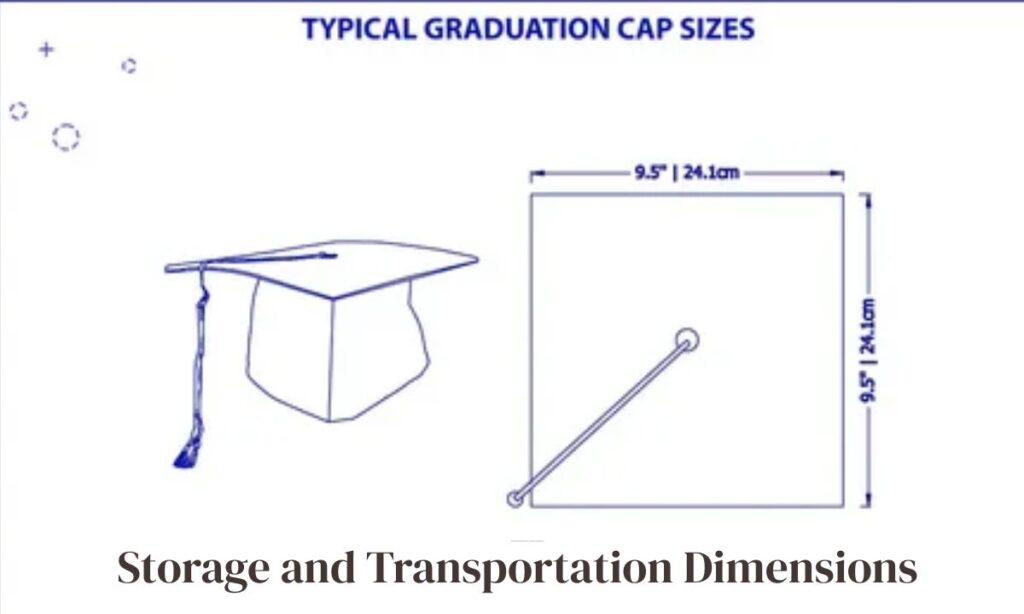The graduation cap, also known as a mortarboard, represents one of the most iconic symbols of academic achievement.
Understanding its precise dimensions is crucial for manufacturers, educators, and students alike. This comprehensive guide explores every aspect of graduation cap measurements, from standard sizing to cultural variations.
The standardized dimensions of these caps ensure uniformity while maintaining the traditional appearance that has defined academic ceremonies for centuries.
How Big Is a Standard Graduation Cap?
A standard graduation cap typically measures 9.5 inches (24.1 cm) square for the top board. This measurement has become the industry standard across most educational institutions in North America.
The overall height of the complete cap assembly ranges from 3 to 4 inches (7.6 to 10.2 cm), depending on the specific design and manufacturer.
The skull cap portion that fits on the wearer’s head usually measures between 7 to 8 inches (17.8 to 20.3 cm) in diameter.
This sizing accommodates most adult head circumferences, which typically range from 21 to 24 inches (53.3 to 61 cm).
These dimensions have been carefully calculated to provide the perfect balance between visual impact and practical wearability.
The Evolution of the Mortarboard
The mortarboard design has evolved significantly since its medieval origins. Early academic caps were round and soft, resembling the caps worn by clergy and scholars.
The transition to the square-topped design occurred during the 15th and 16th centuries, influenced by the building trades where mortarboards were used for carrying mortar.
Historical records show that early mortarboards varied considerably in size. Some measured as large as 12 inches (30.5 cm) square, while others were as small as 8 inches (20.3 cm).
The modern dimensions emerged through practical experience and aesthetic considerations. The 9.5-inch square provides optimal visual balance while remaining manageable for wear during lengthy ceremonies.
Standard Dimensions of Graduation Cap Components
The Square Board (Top)
The square board represents the most distinctive element of the graduation cap. Standard dimensions include:
| Component | Measurement | Metric Equivalent |
| Square Board Length | 9.5 inches | 24.1 cm |
| Square Board Width | 9.5 inches | 24.1 cm |
| Board Thickness | 0.125-0.25 inches | 3.2-6.4 mm |
| Corner Radius | 0.5 inches | 1.3 cm |
The board thickness varies depending on the material used. Cardboard versions typically measure 0.125 inches thick, while more durable plastic or composite materials can reach 0.25 inches.
The Skull Cap
The skull cap forms the foundation that secures the mortarboard to the wearer’s head. Key measurements include:
- Diameter: 7.5 to 8 inches (19.1 to 20.3 cm)
- Depth typically ranges between 2 to 2.5 inches (approximately 5.1 to 6.4 cm).
- The crown generally stands about 1 to 1.5 inches tall (2.5 to 3.8 cm).
- Band width varies from 1 to 1.25 inches (roughly 2.5 to 3.2 cm).
The skull cap diameter is designed to fit comfortably on head sizes ranging from 21 to 24 inches in circumference. Most caps include an adjustable band or elastic system to accommodate size variations.
The Tassel
The tassel dimensions complete the traditional mortarboard assembly:
- Its full length extends from 9 to 10 inches (22.9 to 25.4 cm).
- The cord usually measures between 6 and 7 inches long (15.2 to 17.8 cm).
- Tassel head diameter: 1.5 to 2 inches (3.8 to 5.1 cm)
- Hanging portion: 3 to 4 inches (7.6 to 10.2 cm)
The tassel positioning is crucial for proper appearance. It should hang from the front right corner of the square board, extending beyond the edge by approximately 2 inches (5.1 cm). The weight distribution helps maintain proper cap positioning during ceremonies.
Graduation Cap Dimensions Across Academic Levels

Elementary and Middle School Graduation Caps
Elementary school graduation caps often feature modified dimensions to accommodate younger students:
- One common square board size is between 8 and 8.5 inches (20.3 to 21.6 cm).
- Skull cap diameter: 6.5 to 7 inches (16.5 to 17.8 cm)
- The total height ranges between 2.5 and 3 inches (6.4 to 7.6 cm).
These smaller dimensions provide better proportional appearance for children while maintaining the traditional mortarboard silhouette.
Middle school caps typically use dimensions between elementary and high school sizes, measuring approximately 8.75 inches (22.2 cm) square. This graduated sizing approach ensures appropriate fit across different age groups.
High School and Undergraduate Graduation Caps
High school and undergraduate caps use the standard dimensions previously outlined. The 9.5-inch square board has become universal for these academic levels across most institutions.
This standardization facilitates bulk ordering and ensures consistent appearance in group ceremonies.
Manufacturing specifications for these levels typically include:
- Its weight falls within 4 to 6 ounces (113 to 170 grams).
- Material thickness: 0.125 to 0.1875 inches (3.2 to 4.8 mm)
- Attachment points: 4 corner reinforcements
Graduate and Doctoral Graduation Caps

Graduate level caps may feature slightly larger dimensions or enhanced materials:
- An alternative square board size is around 9.5 to 10 inches (24.1 to 25.4 cm).
- Premium materials: Thicker boards, velvet surfaces
- Enhanced stability: Reinforced attachment points
Doctoral caps sometimes incorporate traditional variations, including different colors or materials that distinguish them from undergraduate versions.
However, the basic dimensions remain consistent with standard measurements.
What Influences Graduation Cap Sizes?
Tradition and History
Historical precedent plays a major role in determining graduation cap dimensions. The measurements we use today evolved from centuries of academic tradition.
Medieval universities established many of the proportional relationships that continue to influence modern designs.
Cultural significance also affects sizing decisions. The mortarboard’s distinctive appearance has become so closely associated with academic achievement that major dimensional changes would alter its symbolic meaning.
This traditional weight helps maintain consistency across institutions and generations.
Institutional Specifications
Individual institutions may specify particular dimensions based on their traditions or practical requirements.
Some universities maintain custom sizing that reflects their heritage or ceremony logistics. These variations are typically minor, staying within 10% of standard dimensions.
Bulk procurement often drives standardization, as manufacturers offer better pricing for common sizes. This economic factor encourages institutions to adopt standard dimensions rather than custom specifications.
Materials and Construction: How Dimensions Affect Stability
The relationship between dimensions and stability is crucial for graduation cap design. The 9.5-inch square provides optimal balance between visual impact and structural integrity.
Larger boards become difficult to manage in wind or during movement, while smaller boards may appear disproportionate.
Material selection directly impacts dimensional stability. Cardboard versions may warp or bend, affecting the precise square shape.
Plastic and composite materials maintain their dimensions better but require careful thickness calculations to avoid excessive weight.
Cultural and International Variations in Graduation Cap Dimensions
British Academic Caps
British academic tradition employs different cap styles with varying dimensions.In several UK academic institutions, the traditional trencher cap generally has a square top measuring about 8.5 inches (21.6 cm), slightly smaller than typical US versions.
The mortarboard design in Britain often features a more pronounced curve at the corners.
Oxford and Cambridge maintain distinctive cap styles with unique dimensional requirements. These traditional variations reflect centuries of academic custom and institutional identity.
European Continental Styles
Continental European universities often adopt cap styles that notably differ from the traditional Anglo-American mortarboard..
German academic caps may feature different proportions, while French academic headwear follows entirely different dimensional standards.
Scandinavian countries have developed their own graduation cap traditions with specific sizing requirements.
These cultural variations demonstrate how academic dress adapts to local customs while maintaining ceremonial significance.
Asian Academic Headwear
Asian universities increasingly adopt Western-style mortarboards, but with modifications to suit local preferences.
Japanese academic caps may feature slightly different proportions, while Korean institutions sometimes specify unique dimensional requirements.
Chinese universities have embraced the standard mortarboard design, contributing to the global standardization of graduation cap dimensions.
This international adoption has helped establish the 9.5-inch square as a worldwide standard.
Practical Considerations: Choosing the Right Cap Size
Measuring for the Perfect Fit
Proper measurement ensures comfortable wear and appropriate appearance. Head circumference should be measured at the widest point, typically just above the eyebrows and ears.
This measurement technique provides the most accurate sizing information.
Fitting considerations include hair style, personal comfort preferences, and ceremony duration.
Caps that are too tight cause discomfort, while loose caps may shift or fall during ceremonies. The optimal fit allows for slight movement without compromising stability.
Storage and Transportation Dimensions
Storage requirements affect practical decisions about graduation cap dimensions. Standard caps stack efficiently for bulk storage, with typical storage dimensions being:
- Stacked height: 20 caps per 6 inches (15.2 cm)
- Storage box dimensions: 12 x 12 x 8 inches (30.5 x 30.5 x 20.3 cm)
- Shipping weight: 25 caps per 5 pounds (2.3 kg)
Transportation logistics must account for cap dimensions when planning bulk movements. The standardized sizing facilitates efficient packing and shipping processes.

DIY Graduation Caps: Getting the Dimensions Right
Materials Needed
Creating custom graduation caps requires precise dimensional planning. Essential materials include:
- Cardboard or poster board: 12 x 12 inches minimum
- Measuring tools: Rulers, squares, compasses
- Cutting implements: Craft knives, scissors
- Assembly materials: Glue, tape, fasteners
Template creation ensures consistent dimensions across multiple caps. Professional templates maintain the standard measurements while allowing for customization options.
Construction Tips

Accurate measurement is crucial for DIY success. Use quality measuring tools and double-check all dimensions before cutting.
Construction sequence should follow established patterns to ensure proper fit and appearance.
Quality control during construction helps identify dimensional errors early. Regular measurement checks throughout the building process prevent costly mistakes and ensure professional results.
The Significance of Standardized Dimensions
Visual Uniformity
Standardized dimensions create the visual harmony essential for graduation ceremonies. When hundreds or thousands of graduates wear identical caps, the uniform appearance contributes to the ceremony’s dignity and significance.
Functional standardization simplifies logistics for educational institutions. Ordering, storage, and distribution become more efficient when all caps share identical dimensions.
Symbolic Meaning
The consistent appearance of graduation caps reinforces their symbolic meaning. The familiar 9.5-inch square has become an instantly recognizable symbol of academic achievement.
Dimensional consistency helps maintain this symbolic power across different institutions and time periods.
Cultural recognition depends partly on maintaining familiar proportions. The iconic silhouette created by standard dimensions contributes to the cap’s effectiveness as a symbol of educational accomplishment.
Decorating Within Dimensions: Personalizing Your Cap
Decoration Tips
Personal decoration must work within the constraints of standard dimensions. The 9.5-inch square provides approximately 90 square inches of decorative space.
Design planning should account for the tassel attachment point and corner areas.
Weight considerations become important when adding decorations. Heavy decorations can affect cap stability and comfort. Balanced design ensures that personal touches don’t compromise the cap’s functional performance.
Popular Decoration Approaches
Common decoration methods include:
- Painted designs: Lightweight, permanent options
- Applied decorations: Fabric, paper, or plastic elements
- Printed graphics: Professional-quality images or text
- Dimensional elements: Raised designs within height limits
Decoration guidelines often specify maximum thickness or weight limits to maintain dimensional integrity. These restrictions ensure that personalized caps don’t compromise ceremony appearance or individual comfort.
Conclusion
Understanding graduation cap dimensions is essential for manufacturers, educators, and students involved in academic ceremonies.
The standard 9.5-inch square mortarboard has evolved through centuries of tradition to become the globally recognized symbol of educational achievement.
These precise measurements balance visual impact, practical function, and symbolic meaning.
Dimensional consistency across institutions and academic levels creates the uniform appearance that makes graduation ceremonies so memorable and meaningful.
Whether you’re ordering caps for a large institution or creating a custom design, understanding these standard specifications ensures success.
The careful attention to measurements, from the square board to the skull cap and tassel, reflects the importance placed on academic traditions and the ceremonies that celebrate educational milestones.
Frequently Asked Questions
What is the standard size of a graduation cap?
A standard graduation cap measures 9.5 inches (24.1 cm) square for the top board with a skull cap diameter of 7.5 to 8 inches.
Do graduation cap sizes vary by academic level?
Yes, elementary caps are typically smaller (8-8.5 inches), while high school and college use standard 9.5-inch dimensions.
How do I measure my head for a graduation cap?
Measure your head circumference at the widest point, just above your eyebrows and ears, typically 21-24 inches for adults.
Can I modify graduation cap dimensions for decoration?
Personal decorations should stay within the standard dimensions to maintain ceremony uniformity and cap stability.
Are graduation cap dimensions the same internationally?
While the 9.5-inch square is becoming global standard, some countries maintain traditional variations in their academic headwear.
reed more https://marrygeneral.com/












